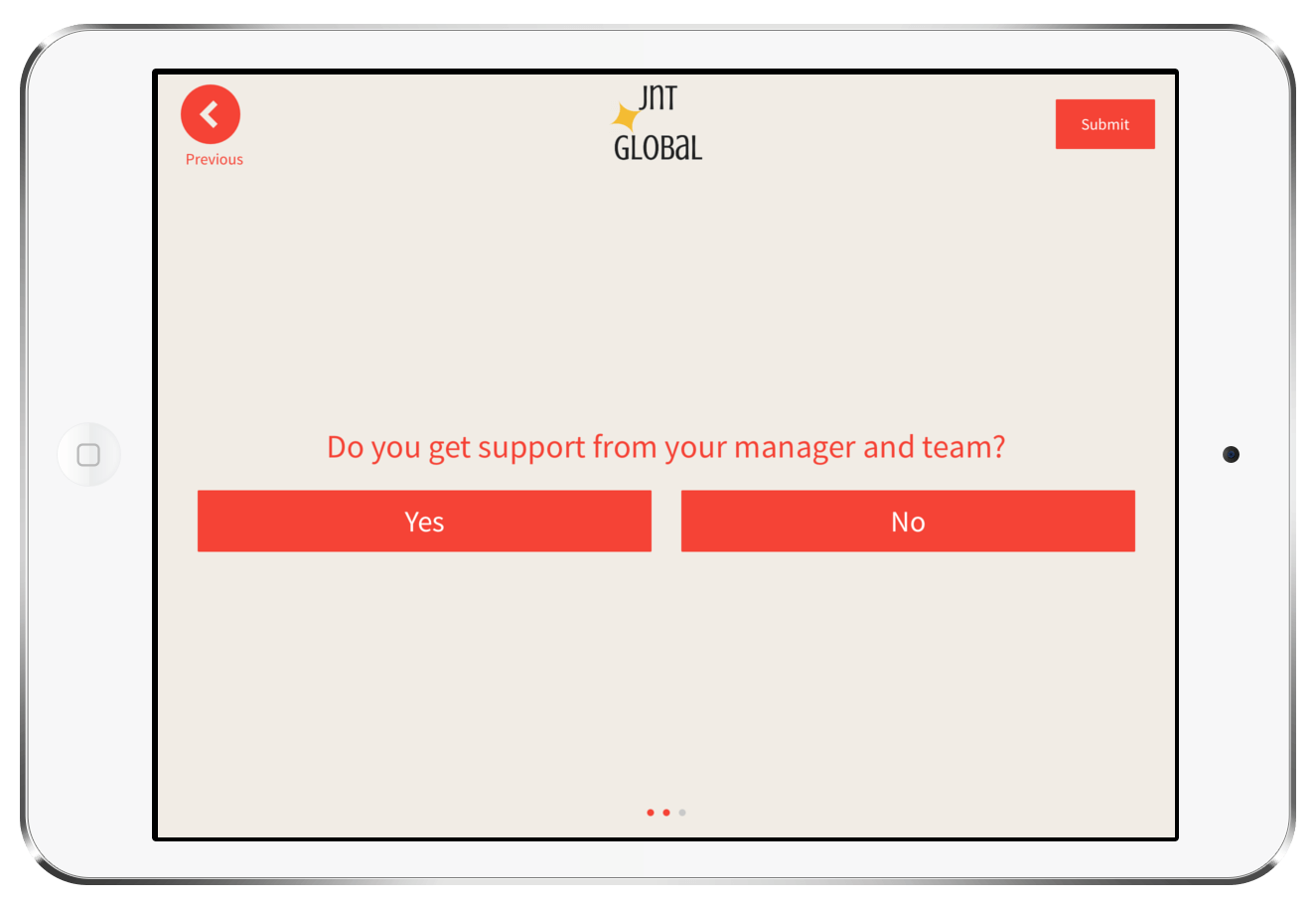Whether you are a human resources professional, a manager, or a business owner, you want your employees to be happy at work. You want a workforce that is productive and isn’t looking to abandon ship. You want employees that contribute to your long-term growth. Employee satisfaction is the base for employee engagement and productivity. Employee satisfaction surveys are a great tool for understanding how satisfied your employees are. They can help you pinpoint what you can do to increase satisfaction. However, you need to get measurable, actionable insight. You need to ask well-chosen, specific employee satisfaction survey questions that don’t generalize employee satisfaction.
What Factors Definitively Impact Employee Satisfaction?
A 2017 survey by the Society for Human Resource Management (SHRM) found that employees consider five factors as the leading job satisfaction contributors. These were: respectful treatment of all employees at all levels, compensation/pay, trust between employees and senior management, job security, and opportunities to use their skills and abilities at work. Other factors that increase job and employee satisfaction include relationships with coworkers and work-life balance.
You must ask specific employee satisfaction survey questions on these contributing factors. Your survey will help you assess current levels of employee satisfaction. By periodically administering these employee surveys, you can discover trends in satisfaction levels. You’ll also learn what measures to implement to promote workplace practices that improve employee satisfaction and increase employee engagement.
Boost Employee Engagement
Measure, analyze and improve employee feedback and reduce employee turnover with Zonka Feedback.

Here are some of the areas on which you should ask employee satisfaction survey questions.
Employee Survey Questions Ideas
- Respectful Treatment of Employees at All Levels
- Compensation /Pay
- Trust Between Employees and Senior Management
- Job Security
- Opportunities to Use Skills and Abilities to Work
- Relationship With Coworkers
- Work Life Balance
Respectful Treatment of Employees at All Levels
The need for respect is a universal human need. Your employees must feel valued, included and safe at work. SHRM found that nearly 65 percent of all employees consider this factor important. However, only 38 percent are very satisfied on this count.
Your employee satisfaction survey questions should include the following questions to measure this factor:
- Are your organization’s workplace discrimination, harassment, and violence policies clearly defined?
- Does management encourage you to report incidents of discrimination, harassment, and violence?
- Do you feel management makes an effort to create a diverse and inclusive workforce?
- Do you think the organization has fair policies for promotion of all employees?
- Please rate how safe you feel at work
To create a culture of respect, provide employees with training and development on workplace respect. You should aim to create a culture that encourages employees to speak up and report harassment and discrimination without reprisals. Employees are more likely to feel respected and be respectful in an organizational culture that values diversity and inclusion, promotes fairly, and, encourages employees to voice opposing views.
Compensation/Pay
Employees that are paid and compensated fairly feel more secure in their jobs. In fact, SHRM found pay and compensation satisfaction to be inversely related to turnover intent. This echoes common sense. Employees that are paid and compensated well are less likely to look for a different job.
Find out how your employees feel about their pay, compensation, rewards package, with the following questions:
- Do you think you are paid fairly in comparison to your local market?
- How satisfied are you with your pay and compensation package?
- How satisfied are you with increases in your compensation?
- Do you clearly understand the company’s compensation policy?
- Do you understand how the organization decided your compensation package?
Employees are more likely to be satisfied with their pay package if they feel it’s fair in relation to the market, and, transparent and equitable across their job role. They must also understand how their pay is decided. You must make pay structure and its administration easily understandable for your employees. Ensure that you clearly communicate to employees how their compensation and benefits are decided. You must also create a fair and unbiased performance evaluation process that your employees can understand.
Trust Between Employees and Senior Management
When organizations foster trust between employees and senior management, they benefit. Employees are likely to be more candid, offer dissenting opinions, and explore innovative ideas. They are also more likely to be motivated and engaged. According to a study, employees in high-trust organizations have more empathy for coworkers and experience less burnout from work. Unfortunately, trust is a difficult thing to define and build.
You must try to use specific employee satisfaction questions to measure factors that lead to trust.
- Do you feel valued at work?
- Does your manager clearly communicate the information required for you to do your job well?
- How would you rate your manager’s openness and transparency in communications?
- How would you rate your manager’s willingness to act on your suggestions and ideas?
- Does your manager explain how the company’s future plans affect you?
You must aim to create a culture of openness, fairness, and transparency with regards to policies, procedures, and communications. Employees are more likely to accept unfavourable results from complaint resolutions if they believe the organization’s policies and procedures are fair and equitable.
Leaders that are accessible contribute greatly to a culture of trust between employees and senior management. Jane McIntyre, former executive director of United Way of Central Carolinas implemented an open-door policy and company-wide emailing as part of her efforts to be more accessible and transparent in communications. Under her leadership, United Way successfully increased funding for local charitable agencies, increased diversity in corporate donors and more.
Job Security
Your team is not going to put in their best efforts if they are worried about losing their jobs. Whether this uncertainty is a result of changes in organizational structure, or downsizing, it’s important to ensure employees understand what their future with the organization could be.
Fifty-eight percent of employees in the SHRM survey consider job security as an important contributor for job satisfaction. However, only 36 percent were satisfied with the stability of employment. Ask the following questions to understand what your employees think.
- How long do you expect to have your current job in the organization?
- Do you believe there are opportunities for clear growth and promotion in your organization?
- Does your organization clearly communicate changes in staffing?
- Does your organization provide employee assistance programs?
Provide employees with training, coaching, and access to employee assistance programs. You must clearly communicate changes in staffing and address employee feelings regarding their position. Don’t leave your employees wondering if the axe will fall on them next.
Opportunities to Use Skills and Abilities at Work
When you empower your employees to use their skills at work, they tend to perform better and have higher job satisfaction. Executive and high-level employees tend to be more satisfied with this factor. This is expected since employees at lower levels can't make decisions regarding their work. However, giving employees at all levels the opportunity to use their skills benefits both them and you. The following employee satisfaction survey questions can uncover whether your employees feel underutilized.
- Do you feel this job utilizes your skills and abilities?
- How challenging do you find your job?
- Does the organization provide opportunities for training and development?
- Does your manager, or someone in management, show an interest in your career aspirations?
- Do you have autonomy to make decisions, set timelines and create goals within your job role?
Conduct person-job fit analyses to ensure you hire the right people for the job in the first place. Encourage managers to provide employees some autonomy within their job role and the opportunity to undertake challenging work. Your employees will experience a sense of fulfillment and motivation. You must also invest in learning and development programs. Create career paths, especially for high-potential employees. Identify employees with the potential to fill employment gaps at higher levels and invest in their training. You will benefit from lower training costs and employee turnover when employees have a clear career path at the organization.
Relationship with Coworkers
Most people work at least 40 hours a week. As a result, employees spend a lot of time with their colleagues. Employees that enjoy better relationships with their coworkers tend to be more satisfied and productive. In fact, understanding how their work relates to their team often makes employees view their work as more meaningful. Here are some questions you can ask to assess employee satisfaction in this regard.
- Do you understand how your work relates to your team?
- Does your team inspire you to do your best at the job?
- Do your team members express disagreements constructively?
- Do you think work is distributed equitably among team members?
- Does your team provide you support and resources for doing your job?
You must create an atmosphere that encourages collaboration among employees. Encourage managers to create collaborative teams where opinions are expressed constructively. Your employees will learn from and teach one another, ultimately enjoying a sense of satisfaction in their relationships. And you will benefit from multiple perspectives for problem resolution and idea generation.
Work-Life Balance
A healthy work-life balance is a key contributor to long-term employee satisfaction. Flexibility in the workplace isn’t just the need of millennials either. Employee burnout can happen at any level and generation. The Harvard Business Review attributes on-the-job factors like long hours, job insecurity, lack of control as direct sources of stress. HBR research estimates workplace stress costs organizations $125 billion to $195 billion in healthcare spending in the U.S. alone.
Its deeper costs include lost productivity, high turnover and the loss of the most capable talent.
You must assess work-life balance in your employee satisfaction survey questions.
- Does your job allow you to strike a balance between work and your personal life?
- Does your job cause an unreasonable amount of stress for you?
- Do you know and understand the organization’s flexible time and paid time off policies available to you?
- Do you understand teleworking policies in place at the organization?
- Does your manager help you achieve a healthy work-life balance?
Flexible work policies, paid time off, a workplace culture that emphasizes a healthy work-life balance can help retain capable talent and increase productivity. You must ensure your employees aren’t suffering from excessive collaboration that leaves less time for individual creativity. Reduce unnecessary organizational complexity. Create teams that don't isolate your high-powered employees. Ensure your employees don't have to take on the brunt of the workload. You should also encourage managers to improve time management and reduce unnecessary meetings.
On top of this, you should try to support your employees whenever you can. For example, you can help them save time while keeping an eye on their health by providing them with meal kit subscriptions or vouchers for healthy prepared meals.
Conclusion: Specific Employee Satisfaction Survey Questions to Impact Performance
Create an employee survey that measures and quantifies the factors that contribute to employee satisfaction. Check out Zonka’s entire library of employee onboarding survey templates, or create an employee survey tailored to your organization. However, employee satisfaction must be measured regularly if you are to create any lasting impact. Use Zonka’s feedback management software to easily send surveys. Track the results in real-time, create reports, and analyze trends. Use employee surveys to help your employees do better at work and improve performance.
Boost Employee Engagement
Measure, analyze and improve employee feedback and reduce employee turnover with Zonka Feedback.





.jpg)




.png)

.jpg)